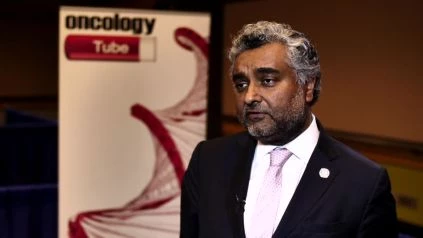Luis G. Paz-Ares, MD, Phd provides an overview of his presentation at ASCO 2019 entitled Efficacy and safety profile of lurbinectedin in second-line SCLC patients: Results from a phase II single-agent trial. In addition, two experts (Rafael Santana-Davila MD of Seattle Cancer Care Alliance and Taofeek Owonikoko MD, PhD, MSCR of the Emory Winship Cancer Institute) give their opinions and a roundtable discussion of the data.
Author(s): Luis G. Paz-Ares, Jose Manuel Trigo Perez, Benjamin Besse, Victor Moreno, Rafael Lopez, Maria Angeles Sala, Santiago Ponce Aix, Cristian Marcelo Fernandez, Mariano Siguero, Carmen Maria Kahatt, Ali Hassan Zeaiter, Khalil Zaman, Valentina Boni, Jennifer Arrondeau, Maite Martinez Aguillo, Jean-Pierre Delord, Ahmad Awada, Rebecca Sophie Kristeleit, Maria Eugenia Olmedo Garcia, Vivek Subbiah; Hospital Universitario 12 de Octubre, CiberOnc, Universidad Complutense and CNIO, Madrid, Spain; Hospital Virgen de la Victoria, Málaga, Spain; Paris-Sud University, Orsay and Gustave Roussy, Villejuif, France; START Madrid-FJD, Madrid, Spain; University Clinical Hospital and Health Research Institute (IDIS), CIBERONC, Santiago de Compostela University School of Medicine, Santiago De Compostela, Spain; Hospital Universitario de Basurto, Bilbao, Spain; Hospital 12 de Octubre, Madrid, Spain; PharmaMar, Colmenar Viejo – Madrid, Spain; PharmaMar, Madrid, Spain; Breast Center, University Hospital CHUV, Lausanne, Switzerland; START Madrid-Centro, Madrid, Spain; Department of Medical Oncology, Cochin Hospital, Paris Descartes University, AP-HP, CARPEM, Immunomodulatory Therapies Multidisciplinary Study group (CERTIM), Paris, France; Medical Oncology Department, Hospital de Navarra, Irunarrea, Pamplona, Spain; Institut Claudius Regaud IUCT-Oncopole, Toulouse, France; Institut Jules Bordet, Brussels, Belgium; University College London Hospitals, London, United Kingdom; Department of Medical Oncology, Ramon y Cajal University Hospital, Madrid, Spain; The University of Texas MD Anderson Cancer Center, Houston, TX
Abstract Disclosures
Abstract:
Background: Lurbinectedin (L) is a novel anticancer drug that inhibits activated transcription and induces DNA double-strand breaks, leading to apoptosis. Methods: A multicenter phase 2 basket trial assessed the efficacy and safety of L in several cancer types, including small cell lung cancer (SCLC). Primary endpoint was confirmed overall response rate (ORR) by RECIST v.1.1. In the SCLC cohort, a target ORR ?30% was set. One-hundred and five patients (pts) with ECOG PS 0-2 who had received one prior chemotherapy line were treated with L 3.2 mg/m2 as a 1-hour i.v. infusion on Day 1 q3wk. Results: Median age was 60 years (range, 40-83), 60% were male, ECOG PS 0/1/2 (32%/62%/6%), liver metastasis 41%, history of CNS involvement 3.8%, prior platinum 100%, median chemotherapy-free interval (CTFI): 3.5 (0-16.1) months; prior immunotherapy (IO): 7.6%. Pts received a median of 4 cycles (range, 1-24). Conclusions: L monotherapy is active in second-line SCLC in both resistant and sensitive disease. The acceptable and manageable safety profile is also associated to a convenient treatment administration (Day 1 q3wk). L as second-line treatment in SCLC emerges as a new promising drug for this unmet clinical need. Clinical trial information: NCT02454972
Overall
(n=105) CTFI<90d
(resistant disease)
(n=47) CTFI?90d
(sensitive disease)
(n=58)
ORR, % (95% CI) (confirmed responses) 35.2 (26.2-45.2)* 21.3 (10.7-35.7) 46.6 (33.3-60.1)
Disease Control Rate (%) at 8 wks 64.8 46.8 79.3
Median DOR (months) (95% CI) 5.3 (3.5-6.4) 4.7 (2.6-5.6) 6.2 (3.4-6.9)
DOR rate at 6 months (95% CI) % 40.3 11.7 50.3
DOR rate at 12 months (95% CI) % 10.6 – 14.7
Median OS (months) (95% CI) ^ 10.8 (6.5-12.2) 5.1 (4.4-8.1) 15.2 (10.2-16.2)
* 5 of 8 pts who failed prior IO had confirmed response DOR: duration of response; ^ Preliminary Myelosuppression was the most common adverse event (AE): G3 (22%) and G4 (23.8%) neutropenia, G3/4 febrile neutropenia (3.8%) and G3/4 thrombocytopenia (6.6%). Secondary prophylaxis or therapeutic G-CSF was given in 15.2%. Most common non-hematological AEs were fatigue (G3: 4.8%), nausea and vomiting (all G1/2). Related serious AEs occurred in 10.5% pts, while treatment-related discontinuations in 3.8%. No treatment-related deaths were reported.

